Articles
- Page Path
- HOME > J Korean Acad Nurs > Volume 41(2); 2011 > Article
-
Original Article
- Endotracheal Colonization and Ventilator-associated Pneumonia in Mechanically Ventilated Patients according to Type of Endotracheal Suction System
- Kyeong-Sook Cha, Ho-Ran Park
-
Journal of Korean Academy of Nursing 2011;41(2):175-181.
DOI: https://doi.org/10.4040/jkan.2011.41.2.175
Published online: April 30, 2011
1Registered Nurse, Department of Infection Control, St. Vincent's Hospital, Suwon, Korea.
2Professor, College of Nursing, The Catholic University of Korea, Seoul, Korea.
- Address reprint requests to: Park, Ho-Ran. College of Nursing, The Catholic University of Korea, 505 Banpo-dong, Seocho-gu, Seoul 137-701, Korea. Tel: +82-2-2258-7406, Fax: +82-2-2258-7772, hrpark@catholic.ac.kr
© 2011 Korean Society of Nursing Science
Abstract
-
Purpose
- This study was conducted to identify endotracheal colonization and the incidence of ventilator-associated pneumonia related to the type of endotracheal suction system.
-
Methods
- The participants in this study were ICU patients hospitalized between October 2009 to March 2010 who used ventilators for over 48 hr with closed (CSS, n=30) or open (OSS, n=32) suction systems. To standardize the pre-intervention suction system, a suctioning protocol was taught to the ICU nurses. Collected data were analyzed using χ2-test, Fisher's exact test, Wilcoxon rank sums test, Wilcoxon test, Log-rank test and Poisson regression.
-
Results
- Endotracheal colonization was higher in OSS than CSS from day 1 to day 8 while using a ventilator and there was a significant difference between the two groups. The CSS reached 50% of endotracheal colonization by the 4th day, whereas for the OSS, it was the 2nd day (p=.04). The incidence of ventilator-associated pneumonia showed no significant difference.
-
Conclusion
- For patients with a high risk of pneumonia, CSS must be used to lower endotracheal colonization.
This article is a revision of the first author's doctoral thesis from The Catholic University of Korea.
- 1. Blackwood B. The practice and perception of intensive care staff using the closed suctioning system. Journal of Advanced Nursing. 1998;28:1020–1029.ArticlePubMedPDF
- 2. Cardeñosa Cendrero JA, Solé-Violán J, Bordes Benítez A, Noguera Catalán J, Arroyo Fernández J, Saavedra Santana P, et al. Role of different routes of tracheal colonization in the development of pneumonia in patients receiving mechanical ventilation. Chest. 1999;116:462–470.ArticlePubMed
- 3. Combes P, Fauvage B, Oleyer C. Nosocomial pneumonia in mechanically ventilated patients, a prospective randomised evaluation of the stericath closed suctioning system. Intensive Care Medicine. 2000;26:878–882.ArticlePubMedPDF
- 4. Deppe SA, Kelly JW, Thoi LL, Chudy JH, Longfield RN, Ducey JP, et al. Incidence of colonization, nosocomial pneumonia, and mortality in critically ill patients using a trach care closed-suction system versus an open-suction system: Prospective, randomized study. Critical Care Medicine. 1990;18:1389–1393.ArticlePubMed
- 5. Diaz E, Rodríguez AH, Rello J. Ventilator-associated pneumonia: Issues related to the artificial airway. Respiratory Care. 2005;50:900–909.PubMed
- 6. Feldman C, Kassel M, Cantrell J, Kaka S, Morar R, Goolam Mahomed A, et al. The presence and sequence of endotracheal tube colonization in patients undergoing mechanical ventilation. The European Respiratory Journal. 1999;13:546–551.ArticlePubMed
- 7. Grap MJ, Munro CL. Preventing ventilator-associated pneumonia: Evidence-based care. Critical Care Nursing Clinics of North America. 2004;16:349–358.ArticlePubMed
- 8. Horan TC, Andrus M, Dudeck MA. CDC/NHSN surveillance definition of health care-associated infection and criteria for specific types of infections in the acute care setting. American Journal of Infection Control. 2008;36:309–332.ArticlePubMed
- 9. Hoshi K, Sasaki C, Ejima Y, Hasegawa R, Wagatsuma T, Matsukawa S. Effect of tube guide assembly of closed suction system on airway pressure gradient. Journal of Anesthesia. 2004;18:59–61.ArticlePubMedPDF
- 10. Jung JW, Choi EH, Kim JH, Seo HK, Choi JY, Choi JC. Comparison of a closed with an open endotracheal suction: Costs and the incidence of ventilator-associated pneumonia. Tuberculosis and Respiratory Diseases. 2008;65:198–206.Article
- 11. Kim MS, Ahn YM, Park IO, Choi SJ, Yoo MY. The effects of open endotracheal suctioning (ETS) and close ETS on oxygen saturation and heart rate in premature infants with respiratory distress syndrome. Journal of Korean Academy of Nursing. 1998;28:529–539.ArticlePDF
- 12. Knaus WA, Wagner DP, Draper EA, Zimmerman JE, Bergner M, Bastos PG, et al. The APACHE III prognostic system: Risk prediction of hospital mortality for critically ill hospitalized adults. Chest. 1991;100:1619–1636.ArticlePubMed
- 13. Kollef MH, Prentice D, Shapiro SD, Fraser VJ, Silver P, Trovillion E, et al. Mechanical ventilation with or without daily changes of in-line suction catheters. American Journal of Respiratory and Critical Care Medicine. 1997;156:466–472.ArticlePubMed
- 14. Korean Association of Critical Care Nurse. Clinical care nursing in ICU. 2004;Seoul, Koonja Publishing.
- 15. Korean Association of Infection Control Nursing. KAICN text of infection control. 2006;Seoul, Dong-Bang Han Publishing.
- 16. Korean Society for Nosocomial Infection Control. Management of nosocomial infection. 2006;3rd ed. Seoul, Han-Mi Medical Publishing.
- 17. Lee ES, Kim SH, Kim JS. Effects of a closed endotracheal suction system on oxygen saturation, ventilator-associated pneumonia, and nursing efficacy. Journal of Korean Academy of Nursing. 2004;34:1315–1325.ArticlePubMedPDF
- 18. Lee SO, Kim ES, Kim HY, Park ES, Jin HY, Ki HK, et al. Korean nosocomial infections surveillance system, intensive care unit module report: Data summary from July 2007 through June 2008. Korean Journal of Nosocomial Infection Control. 2008;13:69–82.
- 19. Lorente L, Lecuona M, Jiménez A, Mora ML, Sierra A. Tracheal suction by closed system without daily change versus open system. Intensive Care Medicine. 2006;32:538–544.ArticlePubMedPDF
- 20. Lorente L, Lecuona M, Martín MM, García C, Mora ML, Sierra A. Ventilator-associated pneumonia using a closed versus an open tracheal suction system. Critical Care Medicine. 2005;33:115–119.ArticlePubMed
- 21. Luaces Cubells C, Fernández Santervás Y, Cambra Lasoasa FJ, Gené Giralt A, López Navarro JA, Gibert Agulló A. Routes of endotracheal colonization in patients with mechanical ventilation. Anales Españoles de Pediatría. 1997;46:20–23.
- 22. Myrianthefs PM, Kalafati M, Samara I, Baltopoulos GJ. Nosocomial pneumonia. Critical Care Nursing Quarterly. 2004;27:241–257.ArticlePubMed
- 23. Park MY. Open vs closed endotracheal suction system: A hemodynamics comparison. 2002;Seoul, Ewha Womans University. Unpublished master's thesis.
- 24. Rosenthal VD, Maki DG, Jamulitrat S, Medeiros EA, Todi SK, Gomez DY, et al. International nosocomial infection control consortium (INICC) report, data summary for 2003-2008, issued June 2009. American Journal of Infection Control. 2010;38:95–104.ArticlePubMed
- 25. Shin HJ, Kim JA, Kwon EO, Noh WK, Kim MY, Noh JS, et al. The effects of hyperventilation and hyperoxygenation before and after endotracheal suctioning using closed-suction system on mechanically ventilated patients. Clinical Nursing Research. 2006;12:97–109.
- 26. Siegel JD, Rhinehart E, Jackson M, Chiarello L. Healthcare Infection Control Practices Advisory Committee. Management of multidrug-resistant organisms in healthcare settings, 2006. American Journal of Infection Control. 2007;35:S165–S193.ArticlePubMed
- 27. Teasdale G, Jennett B. Assessment of coma and impaired consciousness: A practical scale. Lancet. 1974;2:81–84.PubMed
- 28. The Korean Society of Infectious Diseases. Infectious diseases. 2007;Seoul, Koonja Publishing.
- 29. Topeli A, Harmanci A, Cetinkaya Y, Akdeniz S, Unal S. Comparison of the effect of closed versus open endotracheal suction systems on the development of ventilator-associated pneumonia. The Journal of Hospital Infection. 2004;58:14–19.ArticlePubMed
REFERENCES
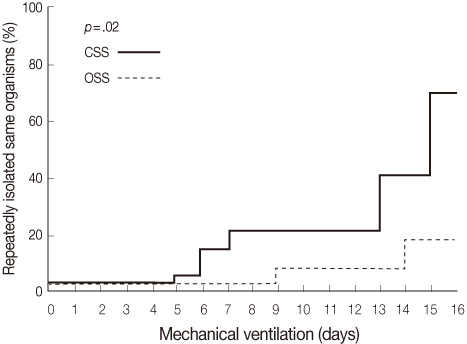
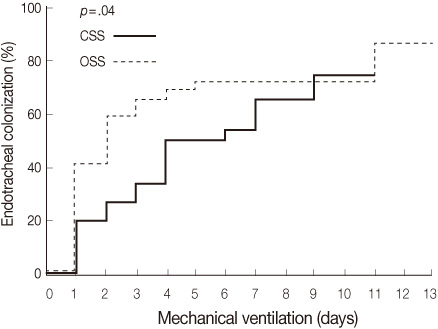
Figure & Data
REFERENCES
Citations

- Development of a Tool for Measuring Ventilator-Associated Pneumonia Prevention Behaviors of Intensive Care Unit Nurses
Sungjung Kwak, Sujeong Han
International Journal of Environmental Research and Public Health.2022; 19(14): 8822. CrossRef - Optimizing effects on airway pressure and minute volume during closed endotracheal suctioning: a simulated lung model
Fang Jung, Shang-Shing P Chou, Shih-Hsing Yang, Jau-Chen Lin, Guey-Mei Jow
SIMULATION.2021; 97(7): 439. CrossRef - Closed Endotracheal Suctioning Impact on Ventilator-Related Parameters in Obstructive and Restrictive Respiratory Systems: A Bench Study
Fang Jung, Shang-Shing P. Chou, Shih-Hsing Yang, Jau-Chen Lin, Guey-Mei Jow
Applied Sciences.2021; 11(11): 5266. CrossRef - Impact of closed suction system on the incidence of ventilator-associated pneumonia, patient colonization and contamination of inanimate surfaces
K.S. Lapin, V.V. Kuzkov, T.V. Chernova, T.V. Galkina, M.Yu. Kirov
Anesteziologiya i reanimatologiya.2020; (4): 32. CrossRef - Who Comes to the Emergency Room with an Infection from a Long-term Care Hospital? A Retrospective Study Based on a Medical Record Review
Kyoung Wan Kim, Soong-Nang Jang
Asian Nursing Research.2018; 12(4): 293. CrossRef - Effects of Normal Saline and Essential Oil Gargling on Bacterial Colonization in Intubated Patients for General Anesthesia
Sang Jin Ko, Yeon Kyung Na, Hae Sook Hong
Journal of Korean Biological Nursing Science.2014; 16(2): 123. CrossRef - A Closed-Suction Catheter with a Pressure Valve Can Reduce Tracheal Mucosal Injury in Intubated Patients
Jin-Heon Jeong, Sung-Jin Nam, Young-Jae Cho, Yeon Joo Lee, Se Joong Kim, In-Ae Song, Sang-Heon Park, Young-Tae Jeon
Korean Journal of Critical Care Medicine.2014; 29(1): 7. CrossRef - Comparison of the Pattern in Semi-Quantitative Sputum Cultures Based on Different Endotracheal Suction Techniques
Jiwoong Oh, Kum Whang, Hyenho Jung, Jongtaek Park
Korean Journal of Critical Care Medicine.2012; 27(2): 70. CrossRef


Figure 1
Figure 2
General Characteristics of Participants
CSS=closed suction system; OSS=open suction system; ICU=intensive care unit; APACHE III=acute physiology and chronic health evaluation III; *Wilcoxon rank sum test; †Fisher's exact test.
A Comparison of Endotracheal Colonization in Study Participants
CSS=closed suction system; OSS=open suction system; MRSA=methicill-in-resistant staphylococcus aureus; IR=imipenem resistance; ESBL=extend-ed-spectrum β-lactamase; †Patients=patients with endotracheal colonization who isolate new bacillus 24 hours after using a ventilator.
Incidence of Ventilator-Associated Pneumonia in Study Groups
CSS=closed suction system; OSS=open suction system. *Relative risk; †95% confidence interval; ‡Ventilator-days/patient-days; §(No. of Ventilator-associated pneumonia/No. of Patient-days)×1,000; ∥(No. of Ventilator-associated pneumonia/No. of Ventilator-days)×1,000.
CSS=closed suction system; OSS=open suction system; ICU=intensive care unit; APACHE III=acute physiology and chronic health evaluation III; *Wilcoxon rank sum test; †Fisher's exact test.
CSS=closed suction system; OSS=open suction system; MRSA=methicill-in-resistant staphylococcus aureus; IR=imipenem resistance; ESBL=extend-ed-spectrum β-lactamase; †Patients=patients with endotracheal colonization who isolate new bacillus 24 hours after using a ventilator.
CSS=closed suction system; OSS=open suction system. *Relative risk; †95% confidence interval; ‡Ventilator-days/patient-days; §(No. of Ventilator-associated pneumonia/No. of Patient-days)×1,000; ∥(No. of Ventilator-associated pneumonia/No. of Ventilator-days)×1,000.
 KSNS
KSNS
 E-SUBMISSION
E-SUBMISSION
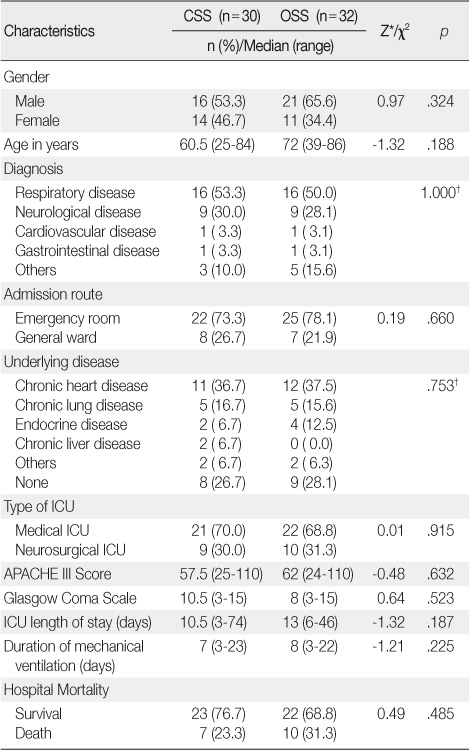
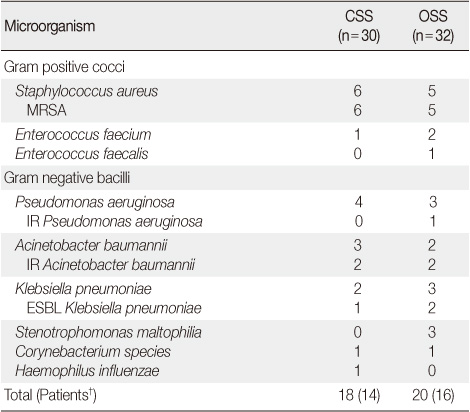
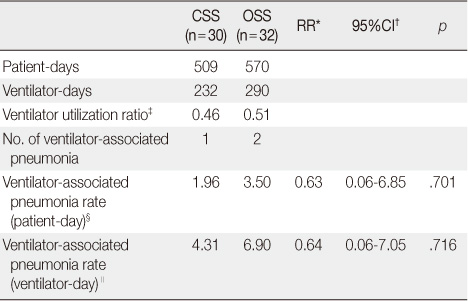
 Cite
Cite

